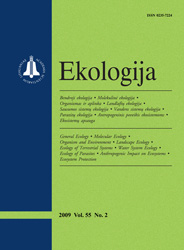 ISSN 0235-7224 ISSN 2029-0586 (online) |
2009 m. Nr. 3-4 Distribution of sand hoppers (Talitrus saltator, Montagu,
1808) on the beach of the Lithuanian Baltic Sea
Talitrus saltator was collected on the Smiltynė beach of the Baltic Sea beside the Curonian Spit in the period 01 07 2005–30 09 2005, taking samples once a week every 1 m from the shoreline to the beginning of dunes. On sand, a frame (0.5 × 0.5 m) was put, and sand hoppers were collected and fixed with 70% ethanol. The highest density of adult Talitrus saltator individuals was found within 4–6 m, of juveniles within 6–5 m, of females 4–6 m and males 4–7 m. The lowest density values were defined beyond the 10th meter from the shoreline up to the dunes. The density of sand hoppers was highest in the middle of September and the lowest in the second half of August. The highest density of adults was fixed in the middle of August and the lowest in the first half of July. The highest density of juveniles was defined in the first part of July and the lowest at the end of the period of reproductive performance, i. e. in the second half of September. The highest values of male and female density were fixed in August–September. The greatest population biomass was defined at the end of July when the density of population individuals was one of the greatest. When juveniles dominated in the population (beginning of July), the least biomass was fixed. The greatest biomass on the beach was established within 4 and 6 meters from the shoreline. The one-factor dispersion analysis (ANOVA) and Pearson’s correlation between the parameters of environment (air and water temperature, intensity of swell, wind speed) and the density / biomass of individuals was estimated. Evaluation of a possible influence of the environmental factors (air and water temperatures, intensity of swell and wind speed) on the density of sand hoppers during the study period revealed no significant correlation between these parameters. Keywords: beach of the Baltic Sea, Talitrus saltator, density, biomass |
Issues:
2011 - Vol.57 No. 1, No. 2 2010 - Vol.56 No. 1-2, No. 3-4 2009 - Vol.55 No. 1, No. 2, No. 3-4 2008 - Vol.54 No. 1, No. 2, No. 3, No. 4 2007 - Vol.53 No. 1, No. 2, No. 2.priedas, No. 3, No. 4 2006 No. 1, No. 2, No. 3, No. 4 2005 No. 1, No. 2, No. 3, No. 4 2004 No. 1, No. 2, No. 3, No. 4 2003 No. 1, No. 2, No. 3, No. 4 2002 No. 1, No. 2, No. 3, No. 4 2001 No. 1, No. 2, No. 3, No. 4 |